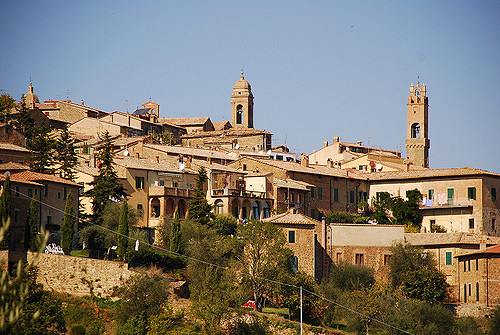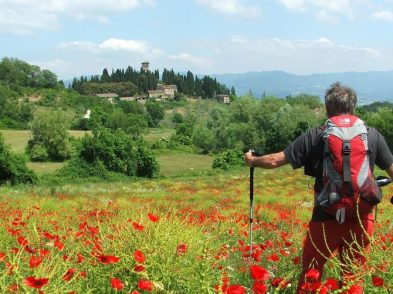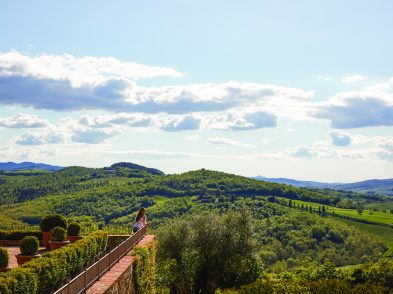Wine lovers the world over visit this terrace overlooking the Val d’Orcia to pay homage to the birthplace of one of the pillars of Italian wine, Brunello di Montalcino. At this time of year in Montalcino, the Sangiovese grapes have been harvested and are quietly transforming into Bacchus’ delicious nectar in more than 200 wineries. Both Rosso and Brunello di Montalcino are made with only Sangiovese Grosso grapes according to strict regulations set out by the Consorzio di Brunello di Montalcino. The different microclimates and soil types on the four sides of the hill result in variations on the theme of the Sangiovese. The best way to discover these differences is to swirl, smell and taste. C’e’ l’imbarazzo della scelta; you are spoiled for choice with the number of wine shops and bars where you can indulge in a wine tasting. If you would rather see where all the magic happens, book guided tours in advance at your favourite wineries, as some are by appointment only, or catch the Wine Bus.
Leave your car in Montalcino and hop on the Wine Bus so you can spend the day tasting Rosso and Brunello di Montalcino, and such other local wines as Moscadello di Montalcino and Sant’Antimo DOC, without worrying about the effects of Sangiovese behind the wheel. This new service, which conveniently chauffeurs wine enthusiasts to participating wineries, runs every Tuesday, Thursday and Saturday through October, leaving as early as 9am; it follows different itineraries for the morning and afternoon trips. Get your tickets at authorized vendors in the city or contact the Pro Loco (located in the old town hall in the centre) for further information. The Wine Bus makes its last stop of the season at the end of October.
Fortezza
Start your tour of Montalcino with a visit to the Fortress, a fine example of military architecture built in 1381. It is open from 9am to 6pm during winter hours and costs 4 euro (6 euro for both the Fortress and museum visits) to climb up to the ramparts. (Enter through the wine shop located in the far corner of the courtyard.) From the top, the surrounding countryside may seem bare after the various harvests, but the brown shades of the tilled land and the autumn-coloured vines are all part of the breathtaking and iridescent natural patchwork quilt that spreads across the Val d’Orcia.
While admiring the view, you can imagine the number of times this fortress has been under attack. English art historian and part time resident in nearby Sant’Angelo in Scalo, Anabel Thomas, recently published Oscar’s Tale, a fantastical story, written in Italian and English, that intertwines facts from the past and fiction from the present about the siege of the Fortress in Montalcino to explain the realities of war to her grandchildren. Refer to the folding map at the back of the book to see the different factions that camped out in their attempts to strike the hilltop stronghold. The Fortress was home to the Republic of Siena from 1555 to 1559 after being defeated by Florence. As such, Siena holds Montalcino in high regard, giving it a place in the historical procession for the Palio.
As you leave the Fortress, walk straight on down via Ricasoli. This street is lined with quaint shops selling wine, souvenirs and honey. Also on the left side of the street, take note of number 32: this is the entrance to Osteria Porta al Cassero, known as ‘da Piero’ by the locals.
Siena’s traditional pici pasta is called ‘pinci‘ here in Montalcino. Put your fork-twirling skills to the test with these handmade strings of pasta in battuto, with the traditional meat sauce, all’aglione, a garlic and tomato sauce, or my personal favorite, alle briciole, simply topped with breadcrumbs and olive oil (see page 20 for a recipe!).
The hearty local fare is deliciously authentic, and the prices are reasonable. It is always quite busy, so get there early enough to get a table.
Go further on via Ricasoli and you will find the Museum of Archaeological, Medieval and Modern collections to your right. Use your combined ticket from the Fortress here to see a noteworthy collection of local archaeological finds that recount the life of this territory, which has been inhabited since Etruscan times, in addition to works by such artists as Duccio di Buoninsegna, Pietro and Ambrogio Lorenzetti and Vincenzo Tamagni.
From the museum, go straight on and take the second left up via Spagni following the brown sign to the Cathedral of San Salvatore, which is only open in the morning. Noteworthy are the remnants of the ancient door to the original parish church on this site located to your left on the inside. Most people stop and admire the view from the garden and hang out on the stone benches for a rest. From here, in the distance you can see Montepulciano on the horizon with Pienza and its white bell tower just before it.
Just along via Spagni, you may find Carlotta Parisi in front of her colourful shop working on her latest project. This young local artist creates papier-mâché sculptures, clay figurines, traditional clay whistles and more.
From the cathedral, head down the two steep blocks of Costa Spagni and turn right to the main square. Piazza del Popolo is the heart of Montalcino for both young and old. Children still play football and ride their bikes in the piazza while the old-timers argue about the latest political scandal under the portico. You may notice the unique clock on the bell tower that only has one hand. Try guessing the time before the bell tolls the hour!
Take via Matteotti to the left of the old city hall until you can turn left down via Donnoli all the way to the end for one of the best views of town itself. Make your way back to the ancient Palazzo Comunale and admire the tiles that are located on the side of the building, near Piazza Garibaldi. Each tile represents a Brunello vintage and indicates the number of stars for that year. On your walk, look carefully at the house numbers to see the colours and names of the four quarters of Montalcino.
Sagra del Tordo
Step back in time on the last weekend of October for the Sagra del Tordo, the Thrush Festival. Food, wine and archery are the focus of this annual event based on past traditions of Montalcino when the four neighbourhoods, or quartieri, battle it out on the archery field for the silver arrow and the glory of victory. Archers are real heroes around here, and children, draped in their quartieri’s colours, tinker with plastic bows and arrows or bang on toy drums in the crowd that follows the historical procession to make offerings to the Lord and Lady of the Fortress. The four quarters set up food stands on both the Saturday and Sunday for lunch in the garden near the Fortress, each with a separate menu of traditional local dishes. There is so much to choose from that you won’t even notice that tordi are not on the menus. It is also possible to feast on their specialities in their halls. This is the biggest event of the year in Montalcino, so book your accommodations and lunch reservations early. Information and schedule of events are available on the Pro Loco website.
Sant’Antimo
Leave some time for a quick trip to the Abbey of Sant’Antimo, located just 9km from the Bacchus roundabout near the stadium. Legend has it that this abbey was built where Charlemagne once lit a votive candle in thanksgiving. There are many legends, but one thing is certain: Sant’Antimo is stunning in all of its simplicity, as it soars up from the valley surrounded by cultivated fields and olive groves. The schedule for the prayer times in Gregorian chant is available at www.antimo.it.
HOW TO GET THERE
Montalcino is just over 40km south of Siena. Take the SR2 to Buonconvento and then turn right and head up the hill 9 km. Do not enter at the first gate where you see the white Montalcino 564 sign. Instead, continue on and shortly after on the left, there are some free parking spaces. Some other free spots are located down viale Roma or behind the city hall on viale Postierla. These free spots may involve a bit of a walk before you start your tour, but they might be worth your while. I have overheard tourists from Rome exclaiming how parking isn’t even as expensive at the Vatican!





